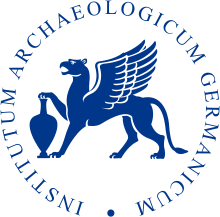German Archaeological Institute

The German Archaeological Institute (German: Deutsches Archäologisches Institut, DAI) is an institution of research within the field of archaeology (and related fields),[1] and a "scientific corporation", under the auspices of the federal Foreign Office of Germany.[2][3]
Origin
Eduard Gerhard was the founder of the institute, according to the homepage of DAI. On the occasion of his leaving Rome, the headquarters of the then Instituto di corrispondenza archeologica, established within Berlin in 1832,[4] from the institute previously founded by Otto Magnus von Stackelberg, Theodor Panofka and August Kestner in 1829 in Rome.
There are offices in many other cities, currently including Madrid, Rome, Istanbul, Athens, Cairo, Damascus, Baghdad, Tehran and Sana'a. Its Romano-Germanic Commission (Römisch-Germanische Kommission), including the world's largest library for prehistoric archaeology, is located in Frankfurt, its Commission for the History of Classical Antiquity in Munich and its Commission for the Archaeology of Non-European Cultures in Bonn.
Hans-Joachim Gehrke was President of the Institute from March 2008 to April 2011,[5] succeeded by Friederike Fless.[6]
An important retired employee is Jutta Meischner. She retired after 35 years of service in the German Archeological Institute in 2000. During this time she continued her studies of late antique portraiture, which culminated in a brief monograph entitled "Portraits of Late Antiquity".
See also
- German Historical Institute
- German Archaeological Institute at Athens
- Projekt Dyabola
- Arachne (archaeological database)
References
- ↑ Deutsches Archäologisches Institut retrieved 12:33GMT
- ↑ Deutsches Archäologisches Institut retrieved 12:26GMT 2.10.11
- ↑ Federal Foreign Office retrieved 12:47GMT 2.10.11
- ↑ Deutsches Archäologisches Institut retrieved 12:38GMT 2.10.11
- ↑ Timeline of Hans-Joachim Gehrke retrieved 16:08GMT 2.10.11
- ↑ Institut für Klassische Archäologie retrieved 16:26GMT 2.10.11
Coordinates: 52°27′38.10″N 13°18′1.27″E / 52.4605833°N 13.3003528°E
|